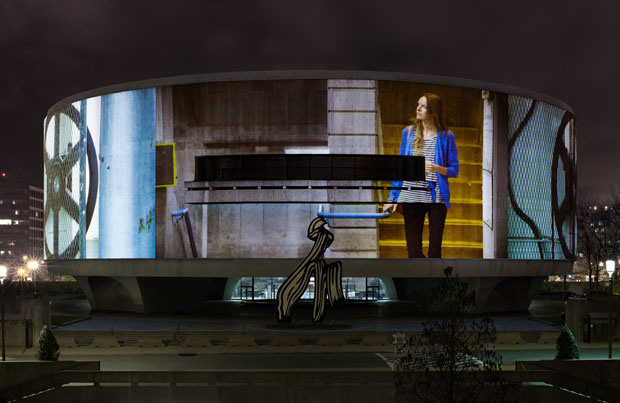Hirshhorn Announces May 11 Symposium for “Doug Aitken: SONG 1”
In honor of the closing week of “Doug Aitken: SONG 1,” the groundbreaking 360-degree projection on the façade of the Hirshhorn that runs through May 20, the museum is staging a special two-part “Happening” May 11. Consisting of a free afternoon symposium and ticketed evening performances, the Happening will expand the public experience of perhaps one of the most monumental iterations of a total work of art.
“‘SONG 1’ works like a new type of earthwork,” said artist Doug Aitken. “Rather than a large-scale landscape piece in a rural setting, this installation transforms the Hirshhorn and corresponding parts of Washington, D.C., into a continuously changing urban earthwork comprising concrete, light, sound, people and the randomness of the modern city.” In the course of nearly eight weeks, a significant audience has sought out “SONG 1,” with many viewers returning for multiple visits. The “Art in the Expanded Field” symposium invites those who have marveled at the incomparable spectacle of the piece to come together to consider its deeper ramifications.
At noon and 3 p.m. May 11, in the museum’s Ring Auditorium, Aitken joins a group of multidisciplinary thinkers and writers, including David Allin, Aaron Betsky, Geeta Dayal, Sasha Frere-Jones, Dean Kuipers and Zabet Patterson. Starting at noon, Dayal, Frere-Jones and Kuipers will discuss “Music and Space.” At 3 p.m., Allin, Betsky and Patterson will examine “Liquid Architecture and the Culture of Modification.”
“Music and Space” addresses the perceptual experience in three dimensions of an art form that has no visual presence. How does a pop song function as a unit of both shared and individual experience?
“Liquid Architecture and the Culture of Modification” asks what it means to (virtually) dissolve a work of architecture in the midst of an urban environment. When technology allows people to radically modify physical realms both temporarily and permanently, what impact do their surroundings, both actual and virtual, have on their understanding of community and urban design?
About David Allin
Allin is a senior associate at Diller Scofidio + Renfro, where he has led art, exhibition and architecture projects since joining the studio in 2006. He is currently running the development of the Bloomberg Balloon, a seasonal inflatable pavilion for the Hirshhorn.
About Aaron Betsky
Betsky is the director of the Cincinnati Art Museum. In 2008 he was director of the 11th Venice International Architecture Biennale. Formerly a designer for Frank O. Gehry and Associates and Hodgetts & Fung Design Associates, he has published more than a dozen books on art, architecture and design.
About Geeta Dayal
Dayal writes frequently on sound, visual art and technology. Her work has appeared in Frieze, Bookforum, The Wire, the Village Voice, the New York Times, the International Herald-Tribune, Print, Wired and Rhizome. She recently received a major grant from the Creative Capital/Warhol Foundation Arts Writers Grant Program.
About Sasha Frere-Jones
Frere-Jones is a staff writer and pop-music critic for The New Yorker. His writing has also appeared in the Village Voice, Spin, the New York Times, the New York Post and The Wire. Also a musician, he is a member of the bands Calvinist and Piñata. His former band Ui released five albums and toured America and Europe.
About Dean Kuipers
Kuipers is an editor at the Los Angeles Times who writes often about music. He collaborated with Aitken on the film Diamond Sea (1997) and the book I Am a Bullet: Scenes from an Accelerating Culture (2000). He wrote “Why We Love Music: Mapping and Remapping Reality in Doug Aitken’s ‘SONG 1’” for the SONG 1 artist’s book.
About Zabet Patterson
Patterson is assistant professor in contemporary art and digital media at Stony Brook University and a core faculty member for the Consortium for Digital Arts, Culture and Technology. She is currently working on two book projects: Control Systems: A Materialist Genealogy of Computational Aesthetics and Visionary Machines: USCO between Technocracy and Techno-utopia.
About the Hirshhorn
The Hirshhorn Museum and Sculpture Garden, the Smithsonian Institution’s museum of international modern and contemporary art, has nearly 12,000 paintings, sculptures, photographs,
mixed-media installations, works on paper and new media works in its collection. The Hirshhorn presents varied exhibitions and offers an array of public programs that explore modern and contemporary art. Located at Independence Avenue and Seventh Street S.W., the museum is open daily from 10 a.m. to 5:30 p.m. (except Dec. 25). Admission to the galleries and special programs is free. For more information about exhibitions and events, please visit hirshhorn.si.edu. Follow the Hirshhorn on Facebook at facebook.com/hirshhorn and on Twitter at twitter.com/hirshhorn. To request accessibility services, please contact Kristy Maruca at marucak@si.edu or (202) 633-2796, preferably two weeks in advance.
# # #
SI-216-2012

